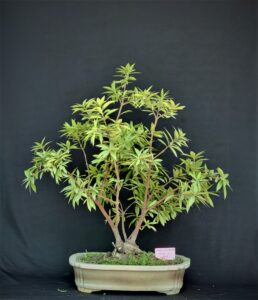The Art of Bonsai: A Comprehensive Guide to Cultivating, Styling, and Caring for Your Miniature Trees. What is a Bonsai?
Bonsai is an art form that involves cultivating small trees in miniature form.
The word “bonsai” is derived from the Japanese words “bon” meaning tray or pot, and “sai” meaning plant. The practice of bonsai is believed to have originated in China, but it was perfected and popularized in Japan.
Bonsai trees are often grown from cuttings or seeds and trained to take on specific shapes and styles using a variety of techniques such as pruning, wiring, and grafting. The end result is a small, yet perfectly formed, tree that can be enjoyed both indoors and outdoors.
In this article, we’ll take a closer look at the history and art of bonsai, the different styles and techniques used to create them, and how to care for these unique and beautiful trees.
The History of Bonsai
The art of bonsai is thought to have originated in China over a thousand years ago. Early Chinese bonsai were large, impressive trees grown in pots and often used as gifts or offerings to royalty. However, it was in Japan where bonsai truly flourished as an art form.
The Japanese refined and perfected the art of bonsai, creating a style that was more refined and elegant. They also developed a deeper understanding of the trees themselves, and how they could be trained and manipulated to create different shapes and styles.
Bonsai quickly became popular in Japan, and by the 14th century, it had become a popular pastime for the upper classes. Bonsai trees were prized possessions and were often passed down from generation to generation as family heirlooms.
During the Edo period (1603-1868), bonsai became more accessible to the general public, and bonsai nurseries began to spring up all over Japan. This led to the development of new styles and techniques, as well as the creation of new species of trees specifically designed for bonsai cultivation.
In the 20th century, bonsai began to gain popularity in the West, and today it is enjoyed by people all over the world.
Styles of Bonsai
There are many different styles of bonsai, each with its own unique characteristics and features. Some of the most popular styles include:
Formal Upright (Chokkan) –
This style is characterized by a straight, upright trunk with branches that gradually decrease in size as they move up the tree.
Informal Upright (Moyogi) –
In this style, the trunk may still be straight, but it will often have a more natural, flowing appearance, with branches that curve and twist.
Slanting (Shakan) –
The trunk of a slanting bonsai is angled to one side, giving it a sense of movement and direction.
Cascade (Kengai) – In this style, the tree’s trunk and branches flow downwards, often spilling over the edge of the container.
Semi-Cascade (Han-Kengai) –
Similar to the cascade style, but with the trunk and branches only partially cascading over the container.
Windswept (Fukinagashi) –
This style is designed to mimic the appearance of a tree that has been shaped by the wind, with branches that all lean in the same direction.
Broom (Hokidachi) –
In this style, the tree has a straight, upright trunk with branches that all start at the same height, giving it the appearance of a broom.
Multi-Trunk (Ikadabuki) –
This style features multiple trunks growing from the same base, giving the tree a more natural, organic appearance.
These are just a few of the many styles of bonsai that can be created. Each style has its own unique characteristics, and the choice of style will often depend on the techniques used to create the desired shape and style.
Techniques Used in Bonsai
Bonsai is an art form that requires a lot of patience, skill, and dedication. To create a beautiful and healthy bonsai tree, there are several techniques that must be employed.
Pruning –
One of the most important techniques in bonsai cultivation is pruning. Pruning involves cutting back the tree’s branches and roots to control its growth and shape. Regular pruning helps to maintain the tree’s desired shape and size, and promotes new growth.
Wiring –
Another common technique used in bonsai is wiring. Wiring involves wrapping wire around the tree’s branches and trunk to guide them into the desired shape. This allows the tree to be trained into a variety of different styles and shapes.
Grafting –
Grafting is another technique used in bonsai cultivation. It involves taking a small branch or bud from one tree and attaching it to another tree to create a new branch or trunk. This technique can be used to create new shapes or to introduce new species of trees to the bonsai world.
Repotting –
As bonsai trees grow, they need to be repotted into larger containers to provide more room for their roots. Repotting is also an opportunity to refresh the soil and prune any roots that have become too long or thick.
Watering and Fertilizing –
Proper watering and fertilizing are essential for maintaining healthy bonsai trees. Bonsai trees need to be watered regularly, but not too much or too little. They also need to be fertilized regularly with a special bonsai fertilizer to ensure they receive the nutrients they need.
Caring for Bonsai Trees
Caring for a bonsai tree requires a lot of patience and attention to detail. Here are some tips for caring for your bonsai tree:
Watering –
Bonsai trees should be watered regularly, but not too much or too little. The soil should be kept moist, but not saturated. Watering should be done in the morning or evening, when the temperature is cooler, to avoid evaporation.
Lighting –
Bonsai trees need plenty of light to grow and thrive. They should be placed in a location that receives plenty of natural light, but not direct sunlight.
Temperature and Humidity –
Bonsai trees thrive in moderate temperatures and humidity. They should be kept in a location that is neither too hot nor too cold, and the air around them should be kept moist.
Pruning and Wiring –
Regular pruning and wiring are essential for maintaining the tree’s shape and size. Pruning should be done when the tree is dormant, and wiring should be done in the spring or fall.
Repotting –
Bonsai trees should be repotted every 2-3 years to provide more room for their roots. Repotting should be done in the spring, when the tree is starting to come out of dormancy.
Conclusion
Bonsai is an art form that has been practiced for over a thousand years. It requires a lot of patience, skill, and dedication to create and maintain these miniature trees. With the right techniques and care, bonsai trees can thrive and provide a lifetime of enjoyment. Whether you’re a seasoned bonsai enthusiast or just starting out, the art of bonsai is a rewarding and fascinating hobby that is sure to bring joy and beauty to your life.
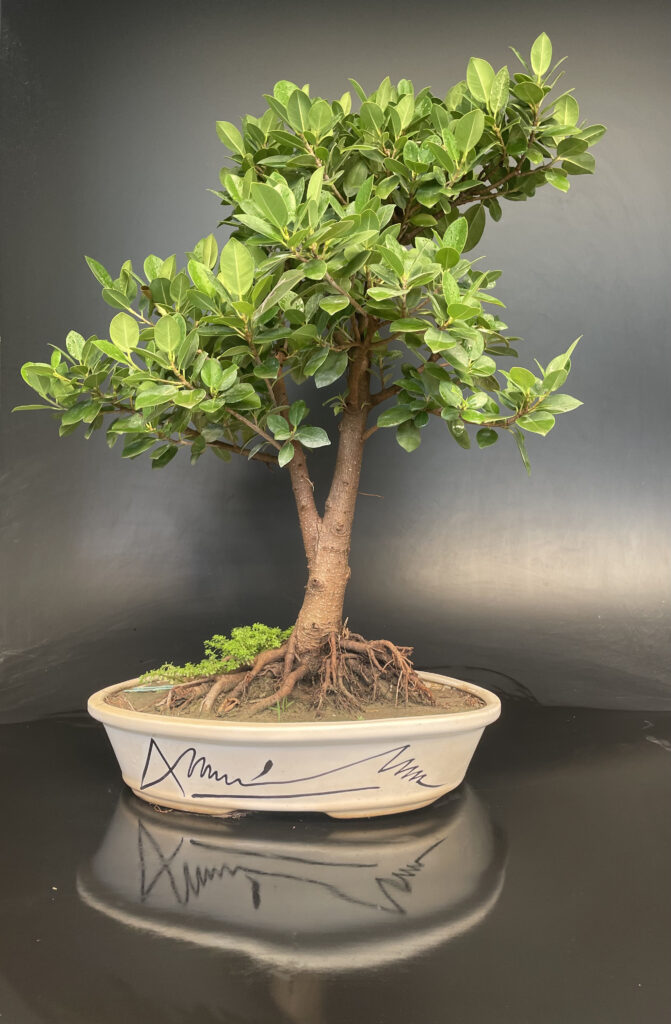
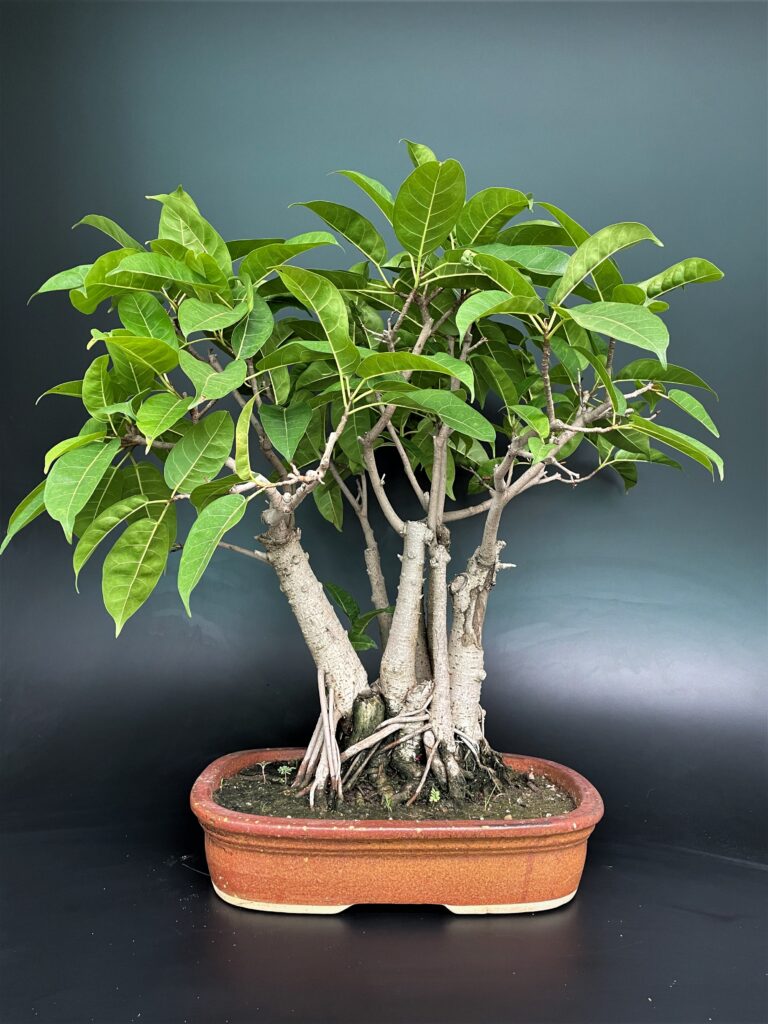
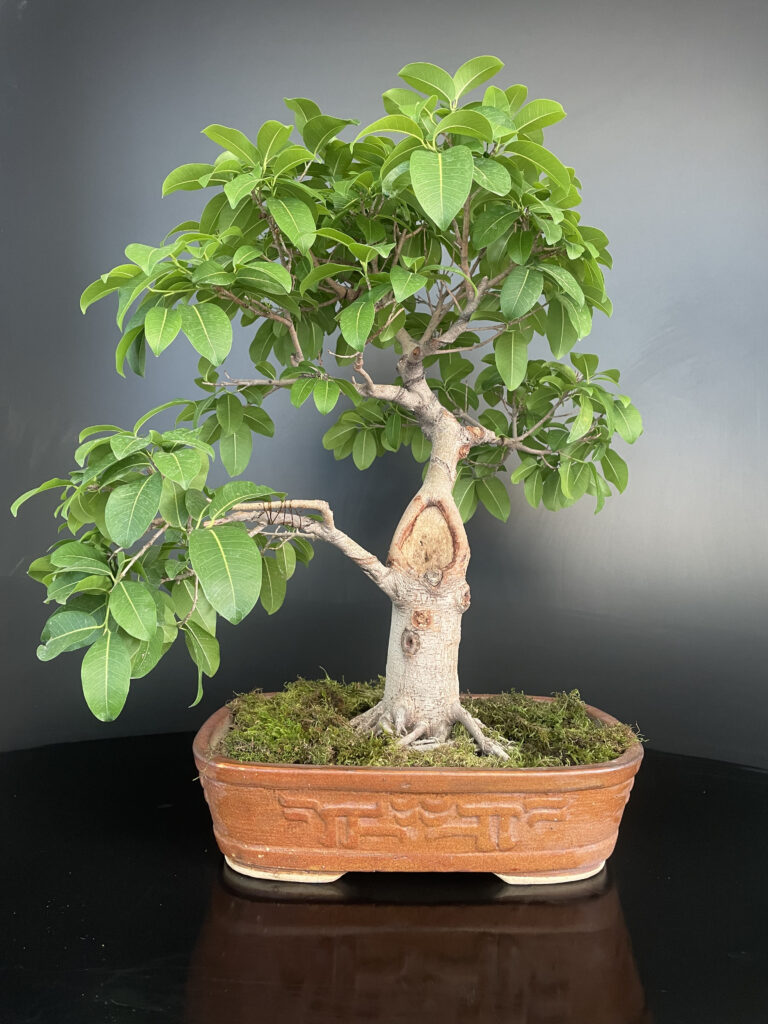
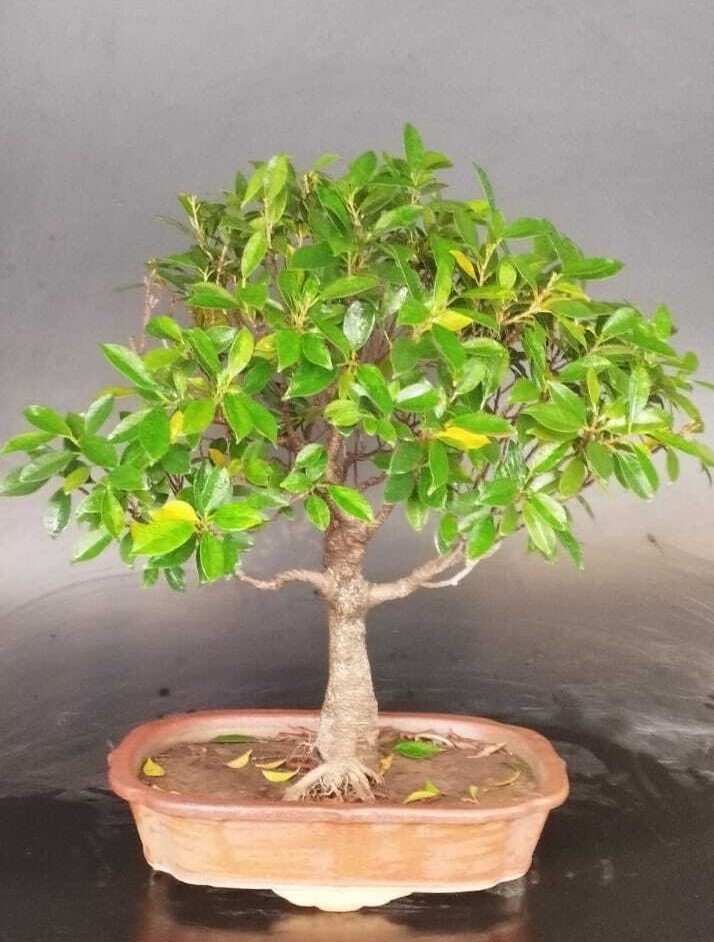
Now we will Discuss below given Points one by one:
Bonsai tree care for beginners
How to shape bonsai trees
Dwarf bonsai tree varieties
Indoor bonsai tree species
Bonsai tree pruning techniques
Bonsai tree soil mix recipe
Bonsai tree fertilizer schedule
Bonsai tree watering tips
Bonsai tree tools and equipment
Bonsai tree styles and aesthetics
Bonsai tree diseases and pests
Bonsai tree winter care
Bonsai tree repotting guide
Bonsai tree species for hot climates
Bonsai tree species for cold climates
Bonsai tree training methods
Bonsai tree wiring techniques
Bonsai tree display ideas
Bonsai tree propagation methods
Bonsai tree outdoor care tips.
Bonsai tree care for beginners
Are you interested in bonsai but don’t know where to start?
Bonsai trees can be great additions to your home or garden, but they do require special care and attention.
Choosing the right bonsai.
The first step in caring for a bonsai is choosing the right bonsai.
There are many types of bonsai, each with its own needs and characteristics. Some popular tree species for beginners include banyan, juniper, and elm.
Be sure to research the specific needs of your species of choice before bringing it home.
Understanding water needs
One of the most important aspects of bonsai care is proper watering. Bonsai need regular watering, but overwatering can be just as harmful as watering under water. To determine when to water your bonsai, check the soil regularly. If it’s dry to the touch, it’s time to water.
Be sure to water the entire pot thoroughly to allow excess water to drain.
Provide plenty of light
Bonsai need plenty of light to thrive, but direct sunlight can be harmful. Place the bonsai in a location with bright indirect light, such as near a window with sheer curtains. If your bonsai does not get enough light, you can supplement it with artificial light.
Maintaining humidity
Bonsai need a certain amount of humidity to stay healthy.
You can increase the humidity by placing a pot of water near the bonsai or by misting it with a spray bottle. Be careful not to miss it too often, as this can lead to overwatering.
Pruning and shaping Pruning and shaping are essential to maintaining the health and beauty of your bonsai.
Regular pruning will help encourage new growth and keep your bonsai in its ideal shape. Use sharp, clean pruners for precise cuts and avoid damaging trees.
Fertilize bonsai trees need regular fertilization to thrive.
Use a balanced, slow-release fertilizer to give your bonsai the nutrients it needs. Follow the directions on the fertilizer package for best results.
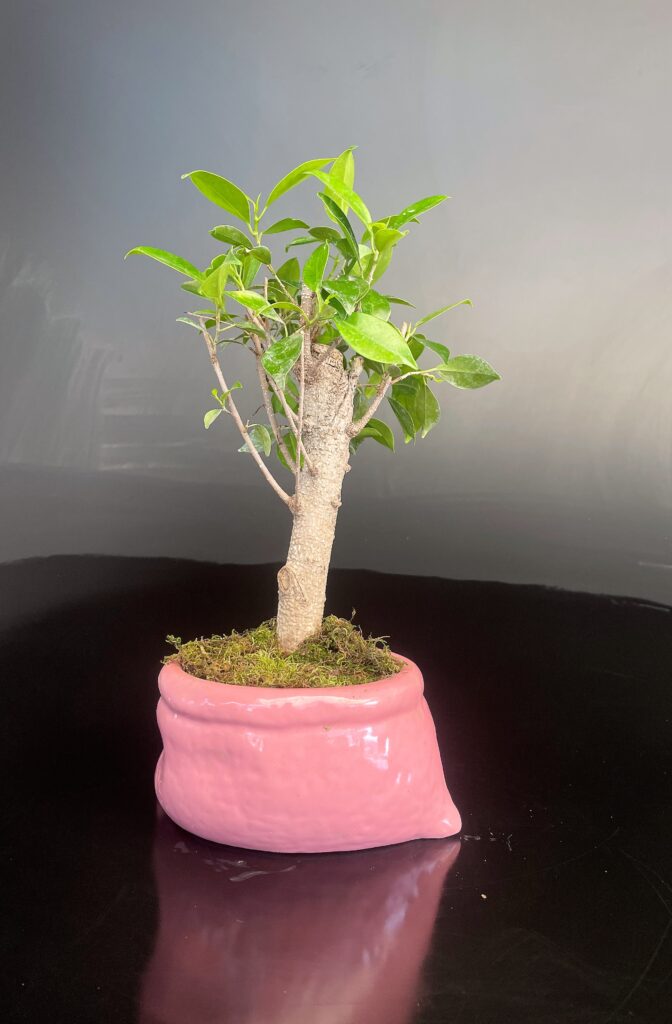


How to shape bonsai trees
Shaping a bonsai involves the careful pruning and training of the tree to achieve the desired form. Here are some general steps to follow:
Determine the desired shape: Before you start shaping the bonsai, you need to have a clear idea of what you want the tree to look like. Look at pictures of bonsai online or in books for inspiration.
Select the right tools: You will need a pair of bonsai shears, wire cutters, and bonsai wire.
Prune the branches: Start by pruning any unwanted branches, particularly those that are growing straight up or down, as well as any branches that are crossing over each other. Prune back the remaining branches to the desired length.
Wire the branches: Once you have pruned the branches, use bonsai wire to gently bend them into the desired shape. Be careful not to bend them too much or you may damage the tree.
Monitor growth: Keep an eye on the tree as it grows and adjust the wiring as necessary to maintain the desired shape. You may also need to prune the tree periodically to keep it in shape.
It’s important to note that shaping a bonsai takes time and patience. It can take years to achieve the desired form, so be prepared to put in the effort and enjoy the process
List of Basic Tools for Bonsai:- Branch Cutter Concave Cutter Chisels Gloves Tweasers Few Rakes Copper Wire of Various Size
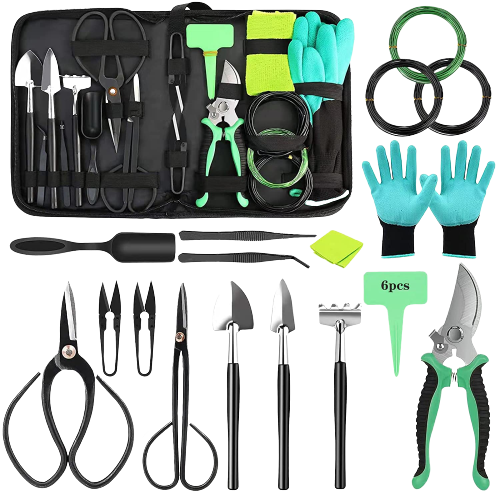
Dwarf bonsai tree varieties
There are many different types of dwarf bonsai trees available, each with its own unique characteristics and requirements. Here are some popular dwarf bonsai tree varieties:
- Fukien Tea (Carmona microphylla)
- Japanese Maple (Acer palmatum)
- Dwarf Hinoki Cypress (Chamaecyparis obtusa ‘Nana’)
- Dwarf Pomegranate (Punica granatum ‘Nana’)
- Dwarf Azalea (Rhododendron spp.)
- Dwarf Gardenia (Gardenia jasminoides ‘Radicans’)
- Dwarf Mugo Pine (Pinus mugo var. pumilio)
- Dwarf Schefflera (Schefflera arboricola)
- Dwarf Jade (Portulacaria afra)
- Dwarf Pygmy Date Palm (Phoenix roebelenii)
Dwarf Pomegranate (Punica granatum ‘Nana’) – This variety produces small, edible fruit and is suitable for bonsai.
Dwarf Banana (Musa ‘Dwarf Cavendish’) – This plant produces sweet, small bananas and can be grown in a pot or as a landscape plant.
Dwarf Mango (Mangifera indica ‘Amrapali’) – This variety of mango tree is a popular dwarf cultivar in India, producing sweet fruit that is smaller than traditional mangoes.
Dwarf Coconut (Cocos nucifera ‘Dwarf Green’) – This variety of coconut tree is smaller than traditional coconut trees and produces smaller coconuts.
Dwarf Lemon (Citrus limon ‘Meyer’) – This variety of lemon tree is smaller than traditional lemon trees and produces sweeter fruit.
Dwarf Guava (Psidium guajava ‘Paluma’) – This variety of guava tree produces small, sweet fruit and is suitable for bonsai.
Dwarf Olive (Olea europaea ‘Little Ollie’) – This variety of olive tree is smaller than traditional olive trees and is suitable for growing in a pot or as a landscape plant.

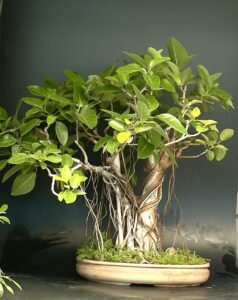 Here is a list of Indian trees that can be used for bonsai.
Here is a list of Indian trees that can be used for bonsai.
Keep in mind that each tree has its own specific needs and requirements, so it’s important to do research and consult with experts before starting a new bonsai project.

Banyan Tree (Ficus benghalensis): Bargad / Barh:-This tree has aerial roots that make for a unique and interesting bonsai. The small size of the bonsai also highlights the intricate details of the bark and leaves.
Juniper (Juniperus chinensis): This evergreen tree is known for its flexibility in shaping and is perfect for bonsai. It has a rugged bark and a conical shape that make for a beautiful addition to any collection. This tree belongs to cold climate conditions, but can be made to bonsai in plains also. Keep out of loo and hot sun during summers.
Indian Lilac (Melia azedarach) Bakain:
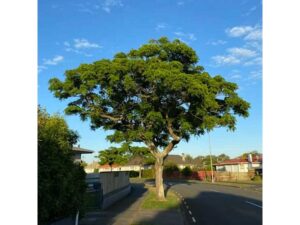 This deciduous tree has a rough texture on its bark and attractive compound leaves. Its small size and unique leaf shape make it an ideal choice for bonsai. Looks like a neem tree.
This deciduous tree has a rough texture on its bark and attractive compound leaves. Its small size and unique leaf shape make it an ideal choice for bonsai. Looks like a neem tree.Indian Cork Tree (Millingtonia hortensis): This tree has a unique, white fragrant flower and a slender trunk that make for an interesting bonsai. It is also known for its quick growth, making it a great option for beginners.
Indian Gooseberry (Phyllanthus emblica), Amla:
 This tree has a rough bark and small leaves that make it a great choice for bonsai. It is also a popular choice for its medicinal properties.
This tree has a rough bark and small leaves that make it a great choice for bonsai. It is also a popular choice for its medicinal properties.Indian Almond (Terminalia catappa): This tree has a beautiful red-brown bark and large, broad leaves. Its unique shape and color make it a great addition to any bonsai collection.
Pomegranate (Punica granatum): This tree has a smooth, gray bark and small leaves. It also produces attractive flowers and fruits that make for a great addition to any bonsai collection.
Indian Coral Tree (Erythrina variegata):
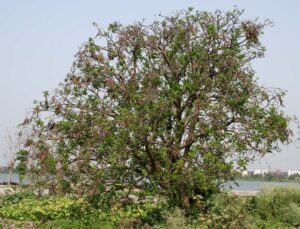 This tree has a striking red-orange flower and rough bark that make it a great choice for bonsai. It also has large leaves that create a unique look when shaped into a bonsai. Pic By I, J.M.Garg, CC BY-SA 3.0, https://commons.wikimedia.org/w/index.php?curid=2596250
This tree has a striking red-orange flower and rough bark that make it a great choice for bonsai. It also has large leaves that create a unique look when shaped into a bonsai. Pic By I, J.M.Garg, CC BY-SA 3.0, https://commons.wikimedia.org/w/index.php?curid=2596250Indian Silver Oak (Dalbergia lanceolaria): This tree has a smooth bark and attractive compound leaves that make it a great choice for bonsai. It also produces small, white flowers that make for a beautiful addition to any collection.
Indian Cherry (Mimusops elengi):
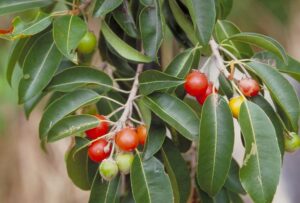 This tree has a smooth, gray bark and small, shiny leaves. Its fragrant flowers and small size make it a great choice for bonsai.
This tree has a smooth, gray bark and small, shiny leaves. Its fragrant flowers and small size make it a great choice for bonsai.Indian Cork Fig (Ficus glomerata): This tree has a unique, corky bark and small, oval leaves that make it a great choice for bonsai. It also produces small, purple fruit that make for a beautiful addition to any collection.
Indian Laurel (Ficus microcarpa): This tree has a smooth, gray bark and attractive, glossy leaves that make it a popular choice for bonsai. It is also known for its easy maintenance and adaptability.
Indian Oak (Quercus serrata): This tree has a rugged bark and unique, lobed leaves that make it a great choice for bonsai. It also produces acorns that make for an interesting addition to any collection.
Indian Beech (Pongamia pinnata): This tree has a rough, scaly bark and small, attractive leaves that make it a great choice for bonsai. It also produces small, white flowers that make for a beautiful addition to any collection.
Indian Coralwood (Adenanthera pavonina): This tree has a striking red flower and small, oval leaves that make it a great choice for bonsai. It is also known for its use in traditional medicine.
Indian Mahogany (Swietenia mahagoni): This tree has a smooth, gray bark and large, broad leaves that make it a great choice for bonsai. It also produces attractive flowers that make for an interesting addition to any collection.
Indian Redwood (Butea monosperma): This tree has a unique, twisted trunk and large, bright orange-red flowers that make it a great choice for bonsai. It is also known for its use in traditional medicine.
Indian Elm (Ulmus wallichiana): This tree has a smooth, gray bark and small, serrated leaves that make it a great choice for bonsai. Its small size and delicate appearance make it a popular choice for beginners.
Indian Ironwood (Mesua ferrea): This tree has a smooth, gray bark and small, shiny leaves that make it a great choice for bonsai. It is also known for its fragrant flowers and use in traditional medicine.
Indian Rosewood (Dalbergia latifolia): This tree has a unique, twisted trunk and attractive, glossy leaves that make it a popular choice for bonsai. Its fragrant flowers and small size also make it a great addition to any collection.
Indian Rubber Tree (Ficus elastica): This tree has a unique, smooth bark and large, glossy leaves that make it a great choice for bonsai. It is also known for its quick growth and easy maintenance.
Indian Wild Fig (Ficus racemosa): This tree has a rugged, gray bark and small, round leaves that make it a great choice for bonsai. It also produces small, edible fruit that make for an interesting addition to any collection.
Indian Sandalwood (Santalum album): This tree has a unique, fragrant wood and small, oval leaves that make it a popular choice for bonsai. It is also known for its use in traditional medicine and fragrances.
Indian Elm Fig (Ficus virens): This tree has a unique, corky bark and small, shiny leaves that make it a great choice for bonsai. Its small size and adaptability also make it a popular choice for beginners.
Indian Kino Tree (Pterocarpus marsupium): This tree has a smooth, gray bark and small, attractive leaves that make it a great choice for bonsai. It is also known for its use in traditional medicine.
Indian Madder (Rubia cordifolia): This vine has small, oval leaves and produces red roots that make it a unique choice for bonsai. It is also known for its use in traditional medicine and textiles.
Indian Rhododendron (Rhododendron arboreum): This tree has a smooth, gray bark and attractive, bright red-pink flowers that make it a great choice for bonsai. Its small size and delicate appearance also make it a popular choice for beginners.
Indian Sweet Gum (Liquidambar orientalis): This tree has a rough, scaly bark and attractive, lobed leaves that make it a great choice for bonsai. It also produces small, spiky fruit that make for an interesting addition to any collection.
Indian Cork Oak (Quercus suber): This tree has a unique, corky bark and small, attractive leaves that make it a great choice for bonsai. It is also known for its use in the wine industry.
Indian Olive (Olea europaea): This tree has a smooth, gray bark and small, oval leaves that make it a great choice for bonsai. Its small size and adaptability also make it a popular choice for beginners.
Indian Beechwood (Gmelina arborea): This tree has a smooth, gray bark and small, attractive leaves that make it a great choice for bonsai. It is also known for its use in traditional medicine and furniture.
Indian Cherry Laurel (Prunus laurocerasus): This tree has a smooth, gray bark and attractive, glossy leaves that make it a great choice for bonsai. Its small white flowers and small black fruit also make it a popular choice for collectors.
Indian Holly (Ilex vomitoria): This tree has a smooth, gray bark and small, shiny leaves that make it a great choice for bonsai. Its bright red berries and small size also make it a popular choice for collectors.
Indian Silverberry (Elaeagnus umbellata): This tree has a rough, scaly bark and attractive, silvery leaves that make it a unique choice for bonsai. Its small, fragrant flowers and edible fruit also make it a popular choice for collectors.
Indian Jasmine (Jasminum mesnyi): This tree has a smooth, gray bark and attractive, yellow flowers that make it a great choice for bonsai. Its small size and delicate appearance also make it a popular choice for beginners.
Indian Olive Plum (Eleagnus latifolia): This tree has a unique, twisted trunk and attractive, glossy leaves that make it a great choice for bonsai. Its fragrant flowers and small, edible fruit also make it a popular choice for collectors.
Indian Redbud (Cercis canadensis): This tree has a smooth, gray bark and attractive, pink-purple flowers that make it a great choice for bonsai. Its small size and unique appearance also make it a popular choice for collectors.
Indian Maple (Acer oblongum): This tree has a smooth, gray bark and attractive, lobed leaves that make it a great choice for bonsai. Its small size and delicate appearance also make it a popular choice for beginners.
Indian Trumpet Flower (Campsis radicans): This vine has a rough, scaly bark and attractive, orange-red flowers that make it a unique choice for bonsai. Its small size and adaptability also make it a popular choice for collectors.
Indian Yellowwood (Cladrastis lutea): This tree has a smooth, gray bark and attractive, yellow flowers that make it a great choice for bonsai. Its small size and delicate appearance also make it a popular choice for collectors.
Indian Cedar (Cedrus deodara): This tree has a rough, scaly bark and attractive, needle-like leaves that make it a unique choice for bonsai. Its small size and fragrant wood also make it a popular choice for collectors.
Indian Laurel Fig (Ficus microcarpa): This tree has a unique, corky bark and small, shiny leaves that make it a great choice for bonsai. Its small size and adaptability also make it a popular choice for beginners.
Indian Privet (Ligustrum sinense): This tree has a smooth, gray bark and small, attractive leaves that make it a great choice for bonsai. Its small white flowers and black fruit also make it a popular choice for collectors.
Indian False Cypress (Chamaecyparis obtusa): This tree has a smooth, gray bark and attractive, needle-like leaves that make it a great choice for bonsai. Its small size and unique appearance also make it a popular choice for collectors.
Indian Mulberry (Morus alba): This tree has a smooth, gray bark and attractive, lobed leaves that make it a great choice for bonsai. Its small, edible fruit and adaptability also make it a popular choice for collectors.
Indian Laurel (Cinnamomum tamala): This tree has a smooth, gray bark and attractive, glossy leaves that make it a great choice
Indian Boxwood (Buxus sempervirens): This tree has a smooth, gray bark and small, glossy leaves that make it a great choice for bonsai. Its small size and adaptability also make it a popular choice for beginners.
Indian Rosewood (Dalbergia latifolia): This tree has a smooth, gray bark and attractive, glossy leaves that make it a great choice for bonsai. Its fragrant wood and small size also make it a popular choice for collectors.
Indian Coral Tree (Erythrina variegata): This tree has a rough, scaly bark and attractive, red-orange flowers that make it a unique choice for bonsai. Its small size and adaptability also make it a popular choice for collectors.
Indian Cork Tree (Millingtonia hortensis): This tree has a unique, corky bark and attractive, white flowers that make it a great choice for bonsai. Its small size and delicate appearance also make it a popular choice for collectors
